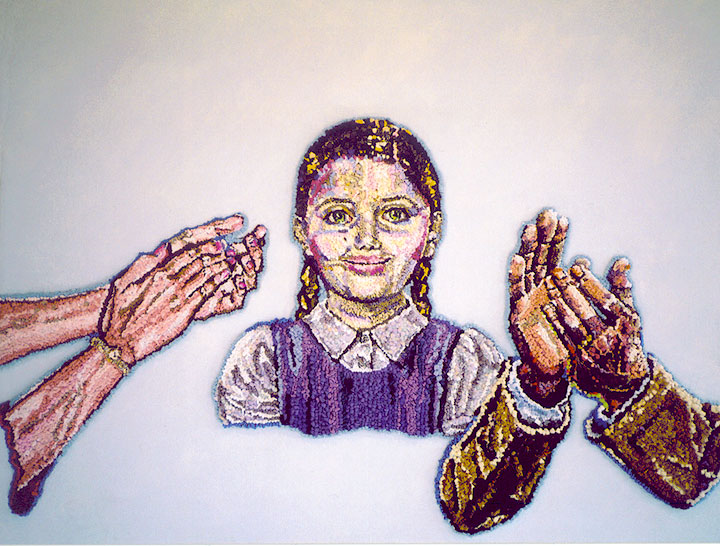
Copyright © Linda Friedman Schmidt, Implausible Applause, discarded clothing, tinted gesso, 40 x 48 in.
Self-Identity Confused
I lost my self-understanding at age 5 on the first day of kindergarten when the teacher called me Lonia. I thought I was Linda. At first I didn’t know she was talking to me. Suddenly discovering that life as I knew it was based on a long-term falsehood was shocking and traumatic. My life narrative was invaded. How could I know what was real going forward? Would I remain the same person if my name was taken away? How could I trust my parents? Why didn’t they tell me about this other name? I could not understand why a name was given and then taken away. A five year old does not think of a name as an arbitrary designation but rather as a guarantee of identity.
New Country, New Self
Shortly after we arrived in the USA quick cultural assimilation became a priority for my parents. The first thing they did was to change all of our first names to American names. As far back as I can remember, and from the time I was six months old, I was Linda. I was never told that I had a different birth name. It was only after I made the discovery in school that my mother and father briefly attempted to explain. But it was too late; I already suffered a major upheaval, a self-identity crisis that would last a lifetime. I felt betrayed, robbed of my story.
Read More
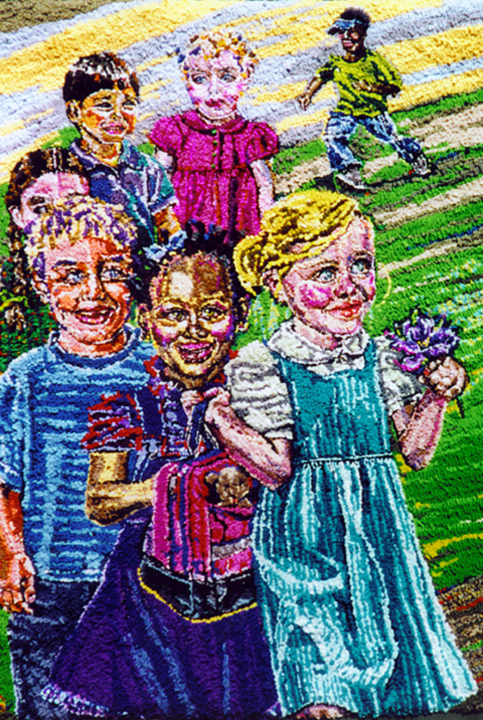
Copyright © Linda Friedman Schmidt, The Power of the Pied Piper, large detail, discarded clothing, 49″ x 48″
America to Me – a Nostalgic View
I recently turned on the radio and heard an unfamiliar Frank Sinatra song “The House I Live In,” also known as “What is America to Me?” Although not a Sinatra fan, the song brought tears to my eyes. Written in 1943 and previously recorded by Paul Robeson, it was featured and sung by Sinatra in the 1945 film of the same name. Both song and movie were created to combat racial prejudice and anti-Semitism at the end of World War II.
Growing up as an immigrant child of Holocaust survivors, America to me was defined by the faces I saw at school and in the street, people of all races, ethnicities, and religions living and working together free and in harmony. America to me was a country of diversity and tolerance, mutual respect and coexistence, a land of opportunity and freedom for all. I was proud to say the “Pledge of Allegiance” at school every day and to sing the “Star Spangled Banner” once a week at school assemblies. America to me was both a home and a country, a place of comfort and peace.
Read More
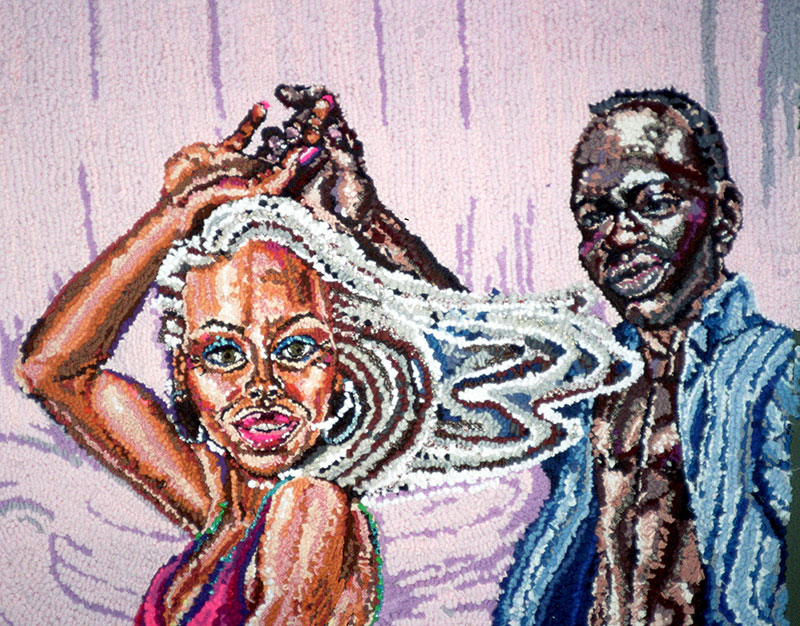
Copyright © Linda Friedman Schmidt, Salsa Cures Sadness No.2: Silver Shines, detail, discarded clothing, 65 x 42 in
Diversity is Celebrated on the Salsa Dance Floor
The salsa dance floor is where people of every race, ethnicity, religion, social class, age, and sexual orientation come together and feel a sense of welcome, belonging, safety, and freedom. It is where dancers white, black, brown, yellow, and every color and culture come together to find refuge and joy, where diversity and multiculturalism come alive. The dancers not only respect one another’s cultures and histories, but also create something new together as they explore a complicated dance that allows for creative expression. They make it their own by combining American, Latin, African, Asian, and European sensibilities.
Diversity, Acceptance, and Connection
There is unconditional love, connection, and pure joy on the salsa dance floor. The diversity of the crowd, the fast music, and the switching of partners with every song enable a connection with people from all over the world in a short period of time. The communication is non-verbal because dance transcends language; it is a universal language. The connection is through the hands (see image); there are elaborate routines of silent communication with fingers telling palms what to make the rest of the body do. There is an emotional connection when you face each other. Dripping sweat doesn’t matter – it’s the connection and the liquid, amazing motion that counts. There is a wonderful sense of physical happiness that comes from using the body to celebrate life. Dancers leave smiling, on a natural high no gym could ever provide.
Read More
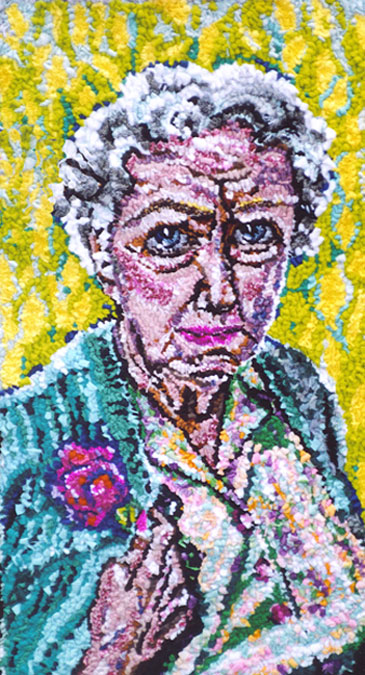
Copyright © Linda Friedman Schmidt, “Before and After,” detail, discarded clothing
Clothing Registers Memory
Clothing is an emotional trigger that carries, stores, and records memory, conjures tactile memory, stimulates sensory and emotional memory. Its close contact to the body gives it the the ability to hold personal and intimate stories from the past. Worn clothing represents traces of lives lived; it is alive with everything it has witnessed, evokes deep feelings, can tell real life tales. Once intended to conceal, the clothes I use to create my artwork reveal and unfold a personal narrative woven from disturbing recollections.
Wearing Traumatic Memories
Epigenetic science tells us that traumatic experiences in our past, or in our family’s past, leave scars adhering to our DNA. These experiences are never gone, even if they have been forgotten. My early childhood was disrupted by trauma. Growing up I carried traumatic experiences and painful memories; I was “clothed” in sadness, uncomfortable in my own skin, itching to get free from memory built on traumatic episodes. Now I shed and shred clothing, the second skin. I deconstruct what I have been wearing, reconstruct and transform it.
Traumatic memory is like grandma’s vintage dress: I can wear it, or have it altered, or cut it up and create something totally new from the fabric.
Read More

Copyright © 2008 Linda Friedman Schmidt, Daddy’s Dummy, discarded clothing, 45″ x 28″
In 2013 the United Nations issued a report on the right to artistic expression and creation because artists all over the world were facing restrictions on their freedom of artistic expression. Many artists then and now still feel trapped between political, religious, cultural, economic, and familial interests. We must remember that according to the Universal Declaration of Human Rights, Article 19, 1948, everyone has the right to freedom of expression. This right includes the freedom to impart information and ideas through any media. Children also have the right to freedom of expression thanks to the Convention on the Rights of the Child, Article 13, 1989.
Why Freedom of Expression is Important to Me
The silence was thick in my childhood home. My parents never spoke about their past history, the war. Their suffering was unspeakable, their stories hidden. I knew I was an artist, but they wanted me to excel at academics, skip grades in school, and conform to my father’s scholarly ideals. I felt controlled, manipulated, objectified. My own voice was silenced. I could not express my true self. I had to hold everything inside, keep my feelings hidden. I had no freedom. Used as a vehicle for my parents’ aspirations, I was never at ease. As a child I had no choice because I could not survive by myself and needed parental approval. Now I will not allow any restriction of my hard won freedom which includes the freedom of artistic expression.
Read More

Copyright © Linda Friedman Schmidt, Between Heaven and Earth, discarded clothing and home textiles, 68 x 41 in
Finding the Balance Between Heaven and Earth
We are all between heaven and earth seeking to find a balance in these turbulent times. There is a hunger to escape from the outer aspects of life, from the world presented to us in the news media: a world of illness, atrocities, inhumanity, and evil, a world of disposable humanity, disposable clothing, and indifference. There are also countless everyday responsibilities and obligations both real and perceived that leave us feeling starved for time and lacking serenity. For me making process-focused art is the way to find balance between the inner and outer, between self and other; it provides a sense of meditative calm, centeredness, and containment from chaos, a sense of fixity, something more enduring. Textiles bring me into a state of absorption and harmony, help me escape from the ordinary limitations of time and space.
Process Art
In process art the making of the work is just as important, if not more important, than the end product. The art is unique and original with no rules to follow, no right or wrong way to explore and create. The artwork is focused on the experience, on the exploration of techniques, tools, and materials. Process art is concerned with the actual doing; the artist can lose himself in its making. It is contemplative in spirit using a combination of repetitive behavior and single-focused concentration to free the mind and invite an inner tranquility.
Read More

Copyright © Linda Friedman Schmidt, Displaced Citizen, discarded clothing, 11 x 11 in. A self portrait inspired by the photo on the artist’s certificate of citizenship
Born Stateless
No child chooses statelessness, having neither a nationality nor a country to call his or her own. It occurs when refugees flee and children are born in displaced persons camps or because of discriminatory laws excluding minority groups from citizenship, or as a result of political change and the redrawing of borders. I was born in Germany to Polish parents. Although I was issued a German birth certificate, my birthplace did not welcome me. German citizenship was and still is determined by inheritance from parents and not by place of birth. I grew up in the United States but did not feel American during childhood. I felt uncomfortable, anxious, and confused about who I was. American citizenship at age 13 did not automatically erase the psychological impact of statelessness.
Who Am I?
For most people, nationality is a part of identity, one of the fundamental ways in which the world defines them and they define themselves. For those born with no country to call their own, no flag to inspire identification, statelessness leads to a deep crisis of identity. With neither a nationality nor a cultural identity, they feel invisible, as if they do not exist. Statelessness causes alienation, feeling isolated from society, separated; there is a sense of dislocation, a feeling of being lost, rejected, unsettled, insecure. There are feelings of not belonging, of being excluded that endure into adulthood even after citizenship is attained.
Read More
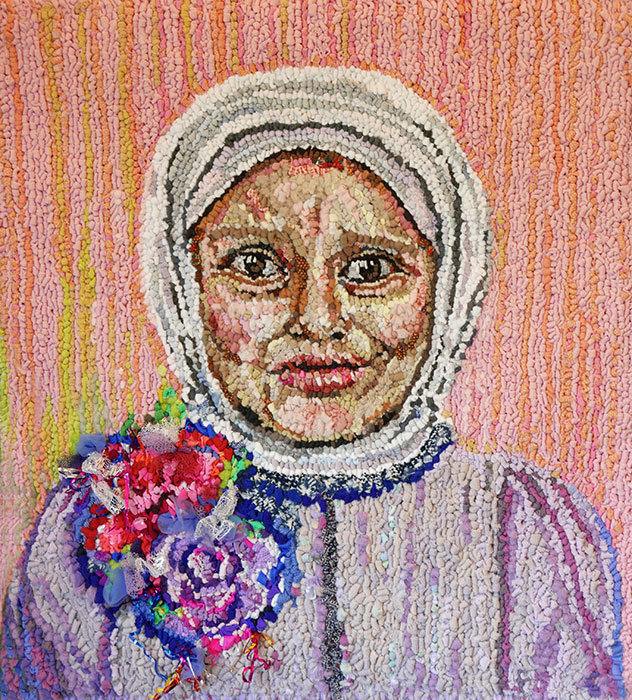
A CORSAGE FOR EVERY GIRL, discarded clothing, 17.5 x 17.5 in
Identification with Refugees, Outsiders
The refugee experience was part of my childhood. That is why I empathize with refugees, those that do not fit in, those that are part of the current global refugee crisis. My parents were asylum seekers too, included in the post World War II worldwide influx of refugees. They had no money and spoke no English when they came to New York City with their baby, me. HIAS, an organization that aids refugees who have been forced to flee their homelands, helped us to get an apartment and resettle in East New York, Brooklyn, largely a community of outsiders made up of Eastern European refugees, Puerto Ricans, African-Americans, and a sprinkling of poor whites. The outsiderness of the refugee experience has stayed with me, a self-taught artist making art about outsiders in contemporary society, evocative narrative artwork rooted in humanity’s suffering.
Outsider/Insider Artist
Many think that an outsider artist must be either a mental patient or a poor, uneducated black person from the South creating “raw” art uncontaminated by the larger world. But in reality an outsider artist can also be an insider, someone well-educated who has lived a close to normal life without an opportunity to attend art school, someone like myself driven with a passion to express herself propelled by psychological wounds that need healing, someone with an intense desire to complete herself, to act on innate impulses stifled in childhood, to finally make the art that must be made, art that expresses emotional experience.
Read More
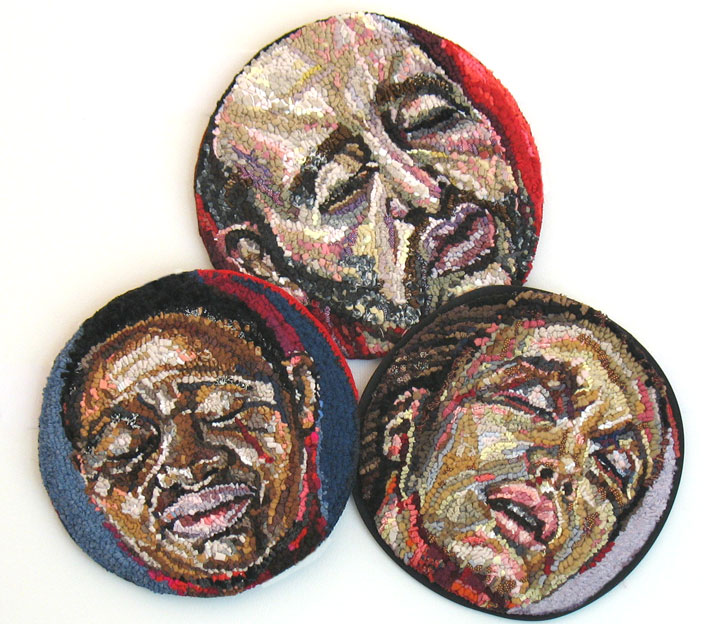
Copyright Linda Friedman Schmidt, Heads Roll, discarded clothing, frisbees, heads 9.75-10.5 in. can be repositioned, turned, rolled, arranged in multiple configurations
Past is in the Present
Activist art can be a vehicle for both personal and collective transformation and healing. My own art activism is motivated by personal history and driven by current social, cultural, and political issues. In global-minded textile narratives, I interweave the problems of the past with the struggles of the present. Lingering echoes of the Holocaust in the modern world disturb me. We are living in a world of disposable humanity, disposable clothing, and indifference. Members of my family were once disposable too. They were murdered during the Holocaust. The surviving family members ended up in the displaced persons camp where I was born.
Despite that dark lesson of history, racial hatred, intolerance, genocide, and other human rights violations continue in today’s world. Innocent human beings are being subjected to biological experimentation, chemical poisoning, dehumanization, exploitation, brutality, torture, execution, and slaughter while many turn a blind eye and remain silent. Millions of people have been forced to flee their homes and their homelands, their lives uprooted by disasters, war, chaos, racial and religious hatred. We are witnessing the biggest wave of refugees since World War II, their treatment evoking memories of Europe’s darkest hour. With hundreds of thousands more asylum seekers trapped in overcrowded displaced persons camps, the historical parallels are inescapable.
Read More









